

|
| ČESKÁ REPUBLIKA | CZECH REPUBLIC |
| Ústecký kraj | Ústí nad Labem region |
| Okres: Teplice |
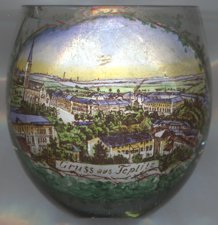 Teplice is situated at an elevation of 204 m between the Krušné hory (Ore Mountains) and
the České Středohory (Bohemian Mid-Highland Mountains) regions.
Teplice is situated at an elevation of 204 m between the Krušné hory (Ore Mountains) and
the České Středohory (Bohemian Mid-Highland Mountains) regions.
The history of Teplice is tightly associated with its famous hot springs.
Archeological finds in the area suggest that the springs had already been known some 2,000 years ago.
The first document describing the history of Teplice dates from 1541 and suggests that the springs were
discovered in AD 762. Due to their location near important trading routes, a Benedictine monastery was
founded here in 1158–1164. The name Teplice (German: Teplitz) is derived from the Czech word 'teply', which means 'hot'.
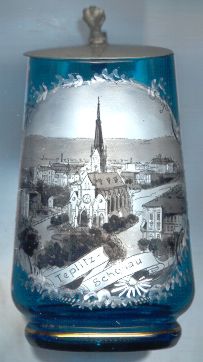 During the 16th century the first spa buildings were set up near the springs, and the place soon gained
a high popularity with the nobility from all over Europe. From the second half of the 17th century on, the
princes Clary-Aldringen invested in Teplice and contributed much to the further development and beautification
of the spa. Probably the most famous visitor of Teplice in the 18th century was Czar Peter the Great, who visited the
hot springs in 1712. During the Seven Years' War (1756–1763) Teplice enjoyed the quite unique status of a
demilitarized city where soldiers of all armies could treat their injuries. The spa also could retain this reputation
as a hospital resort in later wartime conflicts as well. Most of the early architecture of the town was destroyed
in a large fire in 1793.
In 1812, Teplice was the location of the first meeting between the composer Ludwig van Beethoven and the writer
Johann Wolfgang von Goethe, which, however, seemed to have been unfortunate because after that the two refused to talk to each other
again. The pleasant surroundigs are said to have inspired Richard Wagner to write his opera "Tannhäuser".
In 1813, Teplice was the site of a meeting of Czar Alexander I of Russia,
Emperor Franz I of Austria and King Friedrich Wilhelm III of Prussia. The Treaty of Teplitz, signed on the
9th of September of that year united Russia, Austria, Prussia, Sweden and Great Britain in the 6th coalition against Napoleon.
In the late 19th century, Teplitz/Teplice became famous as the "Parlour of Europe" or "Little Paris".
Teplice was merged with Šanov in 1895 and became known as Teplice-Šanov (Teplitz-Schönau).
After World War I, Teplice-Šanov became part of Czechoslovakia and soon regained its popularity as a spa.
After World War II the name of the municipality was shortened to Teplice.
The spa suffered severely during the decades of the Czechoslovak Communist era.
Since the "Velvet Revolution" of 1989 most of the facilities of the spa have been privatized, which has resulted
in a rebirth and renewal of Teplice's architectural beauty.
During the 16th century the first spa buildings were set up near the springs, and the place soon gained
a high popularity with the nobility from all over Europe. From the second half of the 17th century on, the
princes Clary-Aldringen invested in Teplice and contributed much to the further development and beautification
of the spa. Probably the most famous visitor of Teplice in the 18th century was Czar Peter the Great, who visited the
hot springs in 1712. During the Seven Years' War (1756–1763) Teplice enjoyed the quite unique status of a
demilitarized city where soldiers of all armies could treat their injuries. The spa also could retain this reputation
as a hospital resort in later wartime conflicts as well. Most of the early architecture of the town was destroyed
in a large fire in 1793.
In 1812, Teplice was the location of the first meeting between the composer Ludwig van Beethoven and the writer
Johann Wolfgang von Goethe, which, however, seemed to have been unfortunate because after that the two refused to talk to each other
again. The pleasant surroundigs are said to have inspired Richard Wagner to write his opera "Tannhäuser".
In 1813, Teplice was the site of a meeting of Czar Alexander I of Russia,
Emperor Franz I of Austria and King Friedrich Wilhelm III of Prussia. The Treaty of Teplitz, signed on the
9th of September of that year united Russia, Austria, Prussia, Sweden and Great Britain in the 6th coalition against Napoleon.
In the late 19th century, Teplitz/Teplice became famous as the "Parlour of Europe" or "Little Paris".
Teplice was merged with Šanov in 1895 and became known as Teplice-Šanov (Teplitz-Schönau).
After World War I, Teplice-Šanov became part of Czechoslovakia and soon regained its popularity as a spa.
After World War II the name of the municipality was shortened to Teplice.
The spa suffered severely during the decades of the Czechoslovak Communist era.
Since the "Velvet Revolution" of 1989 most of the facilities of the spa have been privatized, which has resulted
in a rebirth and renewal of Teplice's architectural beauty.
The Neo-Gothic  church of St. Elisabeth (kostel sv. Alžběty) [left]
was begun in 1862. The nave was finished in 1877. The tower was completed in 1887.
church of St. Elisabeth (kostel sv. Alžběty) [left]
was begun in 1862. The nave was finished in 1877. The tower was completed in 1887.
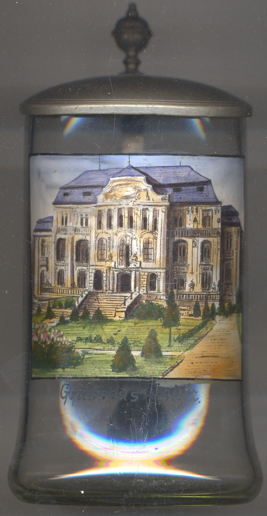
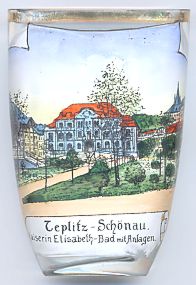
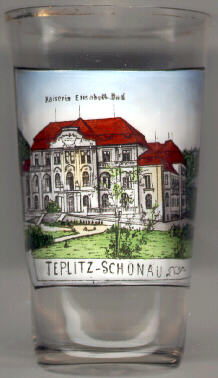
The building of the  Stone Spa (Kamenné lázně)
[left, no. 2346; near right, no. 263; ; far right, no. 3112]
was built in Neo-Baroque and Art Nouveau style in 1911. It was originally named
Kaiserin-Elisabeth-Bad for the wife of Emperor Franz Joseph I of Austria, Empress Elisabeth.
The later name is derived from a stone parapet that was built to prevent the mixing of the hot waters
from the spring with the cold waters of the nearby creek.
Stone Spa (Kamenné lázně)
[left, no. 2346; near right, no. 263; ; far right, no. 3112]
was built in Neo-Baroque and Art Nouveau style in 1911. It was originally named
Kaiserin-Elisabeth-Bad for the wife of Emperor Franz Joseph I of Austria, Empress Elisabeth.
The later name is derived from a stone parapet that was built to prevent the mixing of the hot waters
from the spring with the cold waters of the nearby creek.
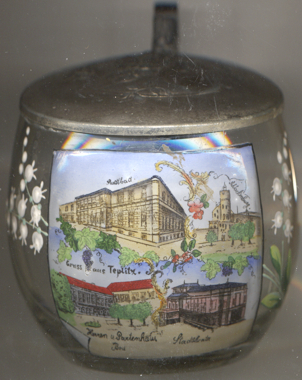
Glass no. 4665 [left] shows four views from Teplice, all labeled in German:
The top left picture shows a view of the
 Stadtbad
Stadtbad
The top right picture shows a view of the inn Schlackenburg (for description see below).
The bottom left picture shows a view of the
 Herrenhausbad
Herrenhausbad
The old  Stadttheater (Municipal Theatre) was built in 1872–1874 by the architect Bernhard Schreiber
in Historicist style. Opened in May 1874, the theatre had a seating capacity of 800. The old theatre was destroyed by a large fire
in 1919. In its place, a new theatre in Classicist revival style was completed in 1924 and today is known as the
Krušnohorské divadlo (Ore Mountains Theatre) and is Teplice's main opera house, also used as a venue for
plays and concerts.
[https://de.wikipedia.org/wiki/Stadttheater_Teplitz, https://en.wikipedia.org/wiki/Kru%C5%A1nohorsk%C3%A9_Theatre]
Stadttheater (Municipal Theatre) was built in 1872–1874 by the architect Bernhard Schreiber
in Historicist style. Opened in May 1874, the theatre had a seating capacity of 800. The old theatre was destroyed by a large fire
in 1919. In its place, a new theatre in Classicist revival style was completed in 1924 and today is known as the
Krušnohorské divadlo (Ore Mountains Theatre) and is Teplice's main opera house, also used as a venue for
plays and concerts.
[https://de.wikipedia.org/wiki/Stadttheater_Teplitz, https://en.wikipedia.org/wiki/Kru%C5%A1nohorsk%C3%A9_Theatre]
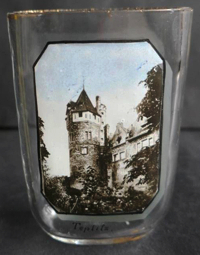
The ruins  Doubravska castle [left, no. 4711] are located on
Doubravska hill (German: Daubersberg) on the eastern outskirts of Teplice. The castle was built after 1478 and completed in 1483.
However, there had been some older fortifications there before that. During the Thirty Years' War (1618–1648), the castle was
occupied by an imperial garrison. Already beginning during the war, the fortifications were demolished between 1644 and 1655.
The ruins of the castle and the mountain were already used for tourism in the spa town in the 19th century. In 1855, the first small
restaurant was established on the site of the former knight's hall. A Roamanticist style extension was created in 1884.
[https://de.wikipedia.org/wiki/Burg_Doubravsk%C3%A1_hora, https://cs.wikipedia.org/wiki/Doubravsk%C3%A1_hora_(hrad)]
Doubravska castle [left, no. 4711] are located on
Doubravska hill (German: Daubersberg) on the eastern outskirts of Teplice. The castle was built after 1478 and completed in 1483.
However, there had been some older fortifications there before that. During the Thirty Years' War (1618–1648), the castle was
occupied by an imperial garrison. Already beginning during the war, the fortifications were demolished between 1644 and 1655.
The ruins of the castle and the mountain were already used for tourism in the spa town in the 19th century. In 1855, the first small
restaurant was established on the site of the former knight's hall. A Roamanticist style extension was created in 1884.
[https://de.wikipedia.org/wiki/Burg_Doubravsk%C3%A1_hora, https://cs.wikipedia.org/wiki/Doubravsk%C3%A1_hora_(hrad)]
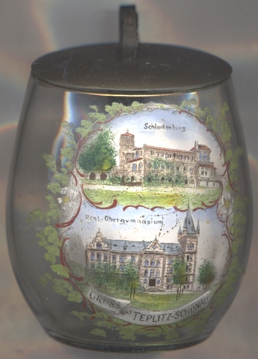
The  Schlackenburg [left, no. 3212: top picture]
was a popular tourist inn, located on Na Letné hill (Spitalberg or Königshöhe)
inmidst of fields, vineyards and orchards. Construction began in 1908 as a simple balcony, but over the
following years until 1826 more and more buildings were added to it. Due to the principal building material,
used bricks, stones and slag, is soon was popularly called Schlackenburg ('Slag castle').
Most famous guests of the inn were King Friedrich Wilhelm III of Prussia, Johann Wolfgang von Goethe
and Richard Wagner, who here wrote his first sketches of his opera 'Das Liebesverbot'.
The buiding continued to be used as a country inn until the 1980s, but then was cleared out and began to fall
into disrepair. Although meant to be broken off, the Schlackenburg was finally declared a cultural monument
in 1987.
[http://audioteplice.cz/text.de.php?id=06]
Schlackenburg [left, no. 3212: top picture]
was a popular tourist inn, located on Na Letné hill (Spitalberg or Königshöhe)
inmidst of fields, vineyards and orchards. Construction began in 1908 as a simple balcony, but over the
following years until 1826 more and more buildings were added to it. Due to the principal building material,
used bricks, stones and slag, is soon was popularly called Schlackenburg ('Slag castle').
Most famous guests of the inn were King Friedrich Wilhelm III of Prussia, Johann Wolfgang von Goethe
and Richard Wagner, who here wrote his first sketches of his opera 'Das Liebesverbot'.
The buiding continued to be used as a country inn until the 1980s, but then was cleared out and began to fall
into disrepair. Although meant to be broken off, the Schlackenburg was finally declared a cultural monument
in 1987.
[http://audioteplice.cz/text.de.php?id=06]
The bottom picture on glass no. 3212 [left] shows a view of the
 Real-Obergymnasium
Real-Obergymnasium
A famous son of Teplice is the Austrian arctic explorer Julius Ritter (Baron) von Payer. Payer was born in 1841 in Šanov (Schönau), today part of Teplice. Together with Karl Weyprecht he headed the Austro-Hungarian North Polar expedition of 1872. They became trapped in the Arctic ice and had to spend two winters in the ice. They also (re)discovered a group of islands in the Arctic Sea and named it "Franz Josef Land" in honour of their emperor. Julius von Payer died in 1915 in Veldes (now Bled, Slovenia).
Another glass in this collection shows a view of Teplice nad Bečvou.
![[scale]](lineal.jpg)